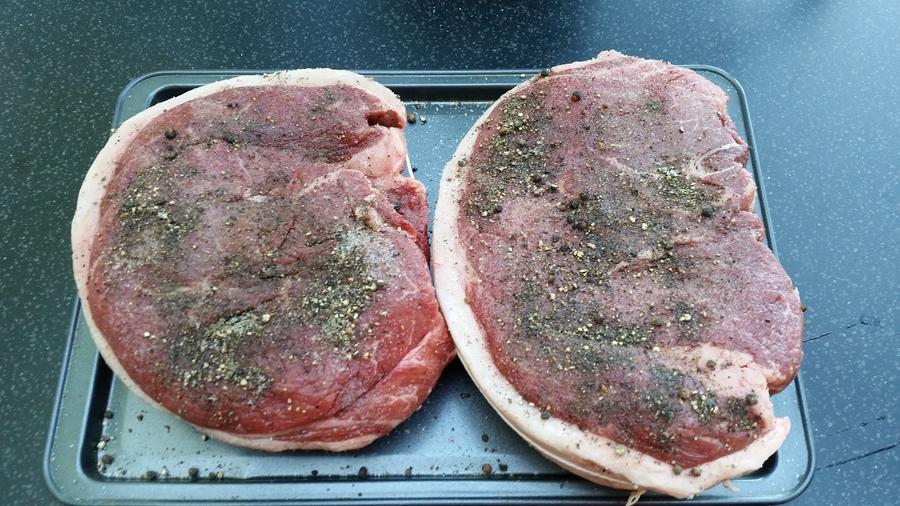Ahhhhh Grasshopper... If a man dwells on the past, then he robs the present. But if a man ignores the past, he may rob the future. The seeds of our destiny are nurtured by the roots of our past.
Biggest problem with the comparison would be trying to time things to do a side by side taste test. Would be easier to do two controlled cooks with same finished IT and similar time for resting. One thing to remember though is that carryover cooking will have more of an effect on the roast cooked at a higher temp, so that might be adjusted for.
Right... The comparison has been completed. You can all stop holding your breath.
The test: We all know that the cheaper meat cuts really benefit from low and show cooking but there was a question about the impact of slow smoking on the more expensive cuts. From my limited experience of trying to smoke the premium cuts of meat low and slow, they have usually ended up tough and almost inedible. When I recently shared my experiences about this others in the UK forum they said that they had slow cooked Rump joints without a problem. The joints I had tried before were smoked in isolation and so to see if I had just been unlucky with the meat just being tough I performed a comparison smoke with two similar joints of Rump side by side.
So to the comparison...
Early in the week I ordered 2 x 1,5 Kg (3.3 pounds) of the finest rump steak as joints. I considered comparing using fillet however irishkamadoguy's original post mentioned Rump. For the rub I used a simple Dead Sea salt and freshly ground black pepper which was applied the day before.
At 9 am on Sunday they were taken out of the fridge to allow them to get up to room temperature before cooking. To reduce any differences resulting from smoker type, both were cooked in Webers. One low-and-slow at 110-115 C (230-240 F) using the Pitmaster IQ-110 for temperature control and the other using the standard Weber charcoal baskets for a roasting temperature of 225 C (440 F). Both were smoked using Hickory pellets on Heat Bead briquettes.
The Low and Slow joint went into the smoker at 12:30 and the smoker temperature was kept at 110-115 C.
To try to have them both reach temperature at about the same time the hot roast joint was put on two hours later at 14:30.
By 15:50 both joints had reached 56 C (133 F) and so as I was aiming for the meat to end up medium rare (final internal temperature of about 63 C (145 F)) I removed the hot roast joint from the smoker at 56 C to allow for the temperature run on, and wrapped it in 3 layers of foil to rest.
As there would be much less temperature run on with the slow cooked joint I continued to cook this for a further 20 minutes until it reached an internal temperature of 62 C (144 F)
I was actually surprised just how far the hot roast joint temperature ran on. The core temperature continued to increase by a further 9 C degrees (16 F degrees) after being removed from the heat. This just goes to show how easy it can be to overcook meat if the temperature run on is not taken into account.
The slow smoked joint on the other hand surprised just how little it ran on. It came out at 62 C and it remained at 62 C whilst wrapped and resting.
After 1 hour resting (1 hour and 20 minutes for the hot roast joint) the foil was opened. The joint on the left is the hot roast and the one on the right is the low roast.
The first thing I noticed was that the slow roast joint was considerably larger than the hot roast and the photo on the right shows just how much juice had come out of each joint while resting. There was considerably more juice from the hot roast joint.
When cut, the slow roast joint (right) was noticeably more juicy. The textures of the two joints were also very different.
My wife was then subjected to the blind taste test. She said that both tasted good however she preferred the slow roast as it had a much softer texture and a much more smokey flavour. I must say that I totally agreed with her. Both meats though I would have been very happy to serve to guests.
Was the difference in texture down to the additional 3 C degrees after the temperature run on with the hot roast? That is difficult to say. The temperatures were much easier to control and predict with the low roast.
I think my previous experiences of premium joints becoming tough when slow smoked must have just been unlucky and the joints would probably have been tough no matter how they were cooked.
Based upon this test I will certainly cook premium joints low and slow in future.
Last edited:
















